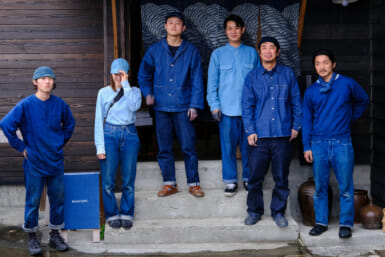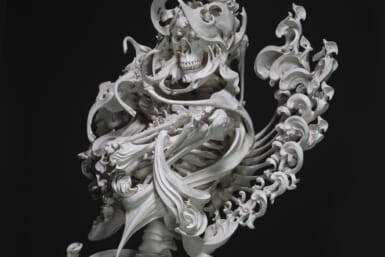I’ve been reading any number of scathing reviews of Anish Kapoor and Cecil Balmond’s proposed sculpture/tower for the 2012 Olympic park in London — a 120-meter tower of looping steel with a price tag that really ought to make any art student boggle. It’s title? The ArcelorMittal Orbit — “ArcelorMittal” being the company owned by steel magnate, Lakshmi Mittal, Europe’s richest man. Mittal is footing most of the bill for the sculpture, and also just so happens to be a sponsor of the Olympic Games. Yes, it is a shameless work of corporate art par excellence.
Is it ugly? Well, (I hope to have an image for you shortly, here. Until then, go here.) it’s most definitely burgundy. I don’t despise it in quite the manner that many bloggers and critics do, and having an affinity for science and things astronomical, I like the idea of its “orbital” structure. But coming from Kapoor, who designed the spectacular “Cloud Gate” in Chicago and whose work is often about pure color, this tower just doesn’t quite seem up to his past standards.
The design, however, is a genuine hybrid of ideas from Kapoor and Balmond, basically stretching the (also burgundy) Marsyas sculpture which Kapoor designed and Balmond engineered for the Tate Modern’s Turbine Hall. The pair appear to have taken the clean surfaces of Marsyas, turned it on its end, added a boatload of steel and an alien-spacecraft observation deck, and brought Balmond’s twisting, balancing-act structural ideas to the mix (as with his work on the Serpentine Pavillion or even more-so the “Spiral” wing of the Victoria and Albert Museum, with its single, continuous wall.)
Still, it’s interesting that “ugly” comes up as a form of valid argument against the ArcelorMittal Orbit (and let’s just go with “Orbit” from here on out. I die a little inside each time I have to type that name.) For the most part, people expect art to be by turns ugly, strange or beautiful. But when it comes to architecture, all of that changes. No one wants an ugly building, and strange won’t win many fans either. And one thing that seems most unsettling about Orbit is that it occupies that uncanny zone between being sculpture and building. As a sculpture, it could easily have been planned on a much smaller scale and had a similar, if not identical, effect. But as a kind of building it feels rather purposeless and self-aggrandizing. There is of course a great history of self-aggrandizing art and architecture out there, so that can hardly be held against it.
Well, maybe it can a little.
The controversy, seemed timely to me, since I had only just visited the city of Mito in Ibaraki last weekend — home to Art Tower Mito, an arts complex including an excellent contemporary arts museum… which I didn’t actually have time to enter.
I did however go to take a look at the tower itself and take a wander around outside the grounds before catching my train back. The Art Tower is a spiraling triangular form that doesn’t look half as stable is it no doubt is, and even the foundation it stands on has built in a way that makes it appear to be sinking into the ground at an uneven angle. Built for the city’s centennial anniversary, it is appropriately 100 meters tall, and as a result it has also become a chief landmark visible from almost anywhere in town.
The tower is weathering a bit poorly, with streaky rust or dirt marks running down its titanium plates, but with its friendly late-modernist lines, it’s an easy structure to like. It is thin and winding, and more akin to an antenna than a building — a beacon for those attending the museum or concert hall. There is a tiny observation room at the top, but otherwise the tower itself is essentially a single showy aspect of an otherwise very functional arts complex.
Yet, amid the rest of the city’s nondescript architecture, it stands out like the proverbial sore thumb, and I was left wondering if there was a similar kerfuffle over its construction in the late 80s. After all, by comparison to Orbit, it doesn’t look all that shocking.
Art Tower Mito was designed by architect Arata Isozaki, whose work also includes the Los Angeles Museum of Contemporary Art and the Kyoto Concert Hall, among others. Isozaki, in this interview, essentially intimates that every architectural project ends up a little behind its time by the time it’s finished. (Although, I’m willing to argue that this time gap is shrinking each year, and Orbit is a prime example.)
Perhaps this kind of delay between conception and execution helps the public to be ready to accept radical new designs. But architecture also plays its part in changing aesthetic values by quite literally altering the public’s physical surroundings. What was avant-garde during its construction, immediately becomes everyday…and eventually becomes standard, or at least representative of a certain period and certain ideas. Future architects then take it as a given, and the process continues to corkscrew around. Much like the Art Tower.
But the public will always remain convinced that their aesthetic judgements are unchanging and somehow universal. (One only has to take a look at fashion to put the lie to that idea.) But when architecture becomes a semi-permanent part of our surroundings with each new building, it can’t simply be ignored. And whether you decide that the process is natural or insidious, it continues to mold the way we see beauty.
There have been more than a few remarks in the news comparing Orbit to the Eiffel Tower, and really the comparison is not so far fetched. The Eiffel Tower was built as an entrance arch to France’s World Fair, and immediately denounced as hideous by most — a fact that’s hard to imagine now. To most, the Eiffel Tower looks proud, traditional, even staid, by architectural and aesthetic standards.
My reservations with Orbit are more political than aesthetic, but if the public eventually takes pride in it, the tower becomes theirs. And with any luck, Lakshmi Mittal will be only a footnote in its history.
-Owen Schaefer










